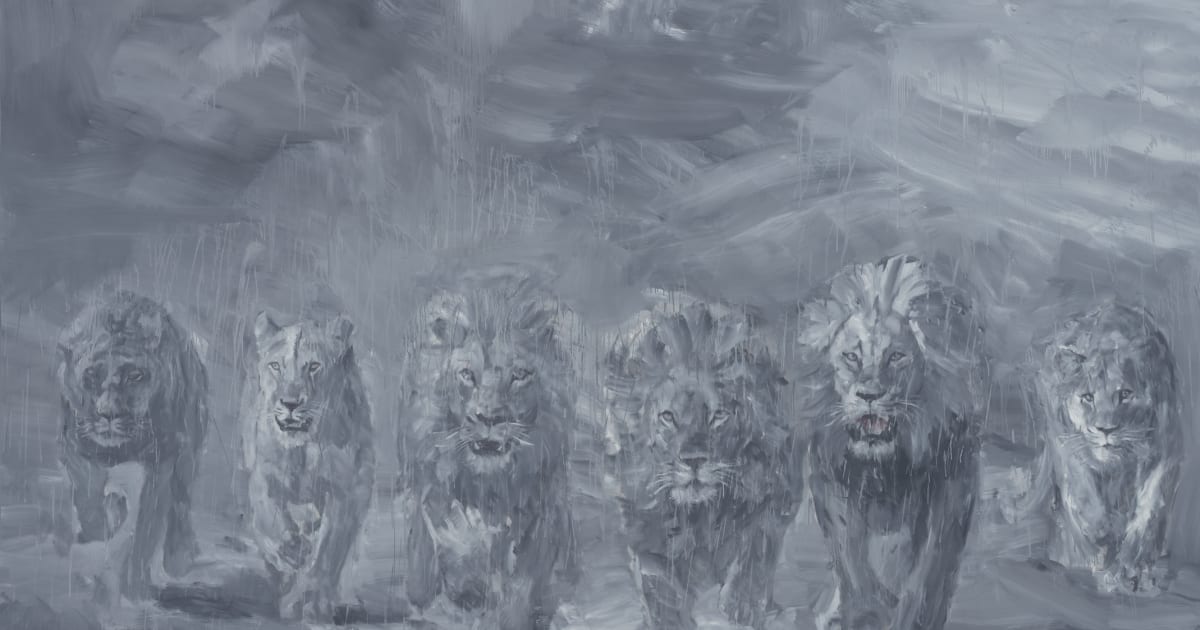Thaddaeus Ropac Paris Pantin presents an exhibition of new works by Yan Pei-Ming, the French-Chinese artist’s first solo presentation in the Pantin gallery. In formats ranging from the monumental to the intimate, Yan Pei-Ming paints a spectrum of subjects – lions and monkeys; Pablo Picasso and the artist himself as Pope – all interspersed with self-portraits. Bridging the animal and the human, the mythical and the personal, tradition and spontaneity, the works on view isolate the shared life force that the artist seeks to articulate across his portraiture practice.
Yan Pei-Ming’s work is invariably indebted to the history of European painting, but in recent years he has increasingly drawn upon his Chinese heritage in combination with Western traditions. In the exhibition, he repeatedly rehearses the motif of the lion, whose art-historical significance resonates across periods and cultures. The two lions that stand sentinel, flanking the entrance of the Pantin gallery, recall the Chinese tradition of guardian lions: an architectural ornament believed to have powerful protective benefits when placed at the entrances of buildings. The artist, whose Dijon studio is stacked high with books on the European Old Masters, also cites Peter Paul Rubens’s Daniel in the Lions’ Den (1614–16), as well as Eugène Delacroix’s depictions of the creature, as influences for his own paintings. The theatricality of Rubens or the romantic drama of Delacroix are transposed into Yan Pei-Ming’s own distinctive painterly language of impassioned brushstrokes and drips of paint. The artist does not execute preparatory sketches before putting brush to canvas: instead, he works directly in paint, forming his figures layer after layer. Though his new works testify to the expressive approach for which he is recognised, he describes them as ‘less impulsive than before’: in the last layer of paint, in particular, he solidifies each image with an intentionality that belies its almost abstract aspect when viewed from up close.
The culmination point of the exhibition is a monumental work in three parts: Autoportrait en trois personnes (2020), first exhibited at the Palais des Papes in Avignon in 2021. It is made up of two self-portraits of the artist that wing a third, central self-portrait of the artist as Pope. Though Yan Pei-Ming, who was born and raised in Shanghai, did not grow up immersed in the iconography of Christianity, it holds a longstanding magnetism for him on account of its centrality to art history, and he first took a Pope as a subject in 2003. In this 2020 work, through his ‘hybridization’ of the recurring themes of the portrait of the Pope and the self-portrait, as curator Henri Loyrette described it, Yan Pei-Ming ‘extends the introspection of the self-portrait into autofiction, […] as if, to quote Rimbaud, he wanted to run through “all the lives owed to him.”’ The work functions like a triptych, a format used since early Christian art and often identified with altarpieces, while its multipart structure provides a sense of narrative, which is carried throughout the exhibition in the sequentiality and dialogue between the faces that stare back at the visitor.
Self-portraiture has been central to Yan Pei-Ming’s practice since he began making art. From monumental canvases to intimate works on oval supports that recall the Renaissance tradition of the portrait miniature – the artist’s first time working on shaped canvases – his new body of self-portraits demonstrates his continued investigation into questions of self-representation by taking up and reworking diverse art-historical conventions. Woven throughout each of the Pantin gallery’s three spaces, his self-portraits are a constant presence in the exhibition, confronting and conversing with the other works in a game of reflections and exchanged glances – each one ‘eye to eye’ with the next – that invites the visitor to meditate on their commonalities.
‘Presence, extraordinary presence is what characterizes the actors featured’, wrote art historian Hans-Joachim Müller on Yan Pei-Ming’s ability to bring together diverse subjects into a single, unified body of paintings; ‘and what unites them to an ensemble’. It is this fundamental essence of the portrait that Yan Pei-Ming distills in the works on view. His self-portraits are an act of ‘looking at himself as somebody else’, as curator Francesco Bonami wrote in the 2017 Rizzoli monograph on the artist; in the same way, his portraits of Picasso, or even those of monkeys – the animal that bridges the gap between human and the other, and ‘our reflection’, as the artist put it – might be said to look into their subjects’ eyes with the same understanding and depth as if the artist were looking into his own eyes in a mirror. ‘I am interested in the human in general’, the artist explained. ‘My work can be seen as a universal portrait. Deep down, what I paint is a version of this humanity.’ His new body of portraits embody this equality, even impartiality, in his treatment of different subjects: what critic Philippe Dagen once called Yan Pei-Ming’s ‘yearning for universality’.
